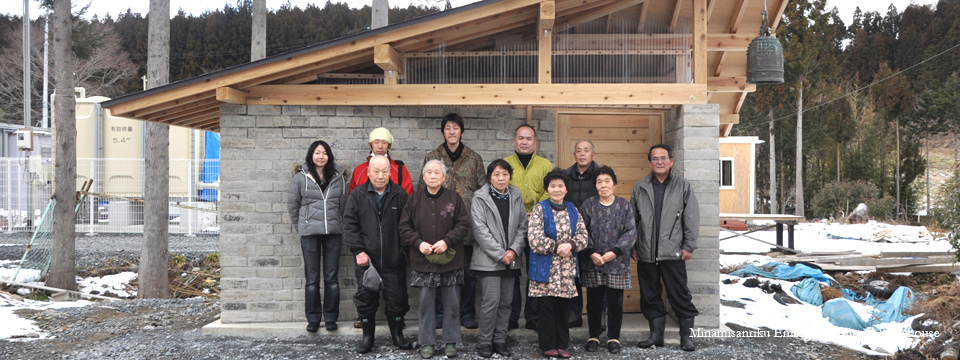


日本語 / ENGLISH

The March 2011 Tohoku Disaster not only caused devastation by engulfing buildings and farmland, but the tsunami also brought salty seawater far inland, rendering soil useless for agricultural use in the near future. Considering the region’s tradition of building with local materials, rather than declaring this land completely futile, NCS is using this salt drenched soil to build.
This project was done with the support of Mitsubishi Corporation Disaster Relief Foundation and Lush Japan Co., Ltd. charity bank.
| End of 2012.7 – 2012.8 | We had a meeting with local people in late July and prepared in Kanto at the same time. Atelier Tekuto who had made drawings created the flask of the earth block. Soil from Togura district, water, sand, gravel and magnesium oxide were necessary as the materials of the earth block, and the mix proportion was reached by Professor Koshiishi and Atelier Tekuto. |
| End of 2011 – 2012.4 | It began with a demand of Mr. Oikawa from General Incorporated Association Minamisanriku Reconstruction Network requested technical offer that they wanted to build i warehouses with earth block which would lead to the preservation of the local culture and history. Though the construction site had not been decided, we collected soil and performed material experiments under Professor Koshiishi of Waseda Universit. We provided technology using earth block previously in Utatsu district and Onagawa-cho in same Miyagi Prefecture. |
| 2012.5 | We started to make soil tiles on the spot in May and held a workshop with local people and volunteers. |
   |
| 2012.3 – 2012.4 | Under Professor Naoyuki Koshiishi of Waseda University who cooperates with us, we collected soil and performed material experiment in February 2012. After that, we had meetings with local people through March and April and confirmed the shape of soil tile and position. At the same time, we made samples and worked on confirmation because the soil tile was also different from the conventional earth block in the shape. |
| 2012.5.24 | Everyone gathered and held the ceremony for completion. After that, Utatsu Geihinkan was presented to Minamisanriku-cho. |
      |
| 2012.5.14-16 | After a curing period, we piled up the earth block for 3 days on 5/14~5/16. |
   |
| 2012.4.15-20 | For 6 days on 4/15~4/20, we held the workshop for producing earth block with team Nikko and local people, and put them for curing. |
   |
| 2011.11-2012.3 | A volunteer group "team Nikko" played a key role and pushed forward the plan of "Utatsu Geihinkan", the meeting place for residents in Utatsu district Minamisanriku-cho Miyagi Prefecture. The building shape became a pit-type.
The ground was clayey and strong, and because they dug all by hand, they wanted to utilize them somehow. That was the beginning.
The main building construction started in the autumn of 2011, and completed January 20, 2012 including roof construction. We performed material experiment with Professor Naoyuki Koshiishi of Waseda University in February. As a result of having a meeting with local staff in March, we decided to use earth block as interior material, chose the shape, and prepared for the construction. |